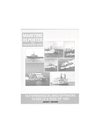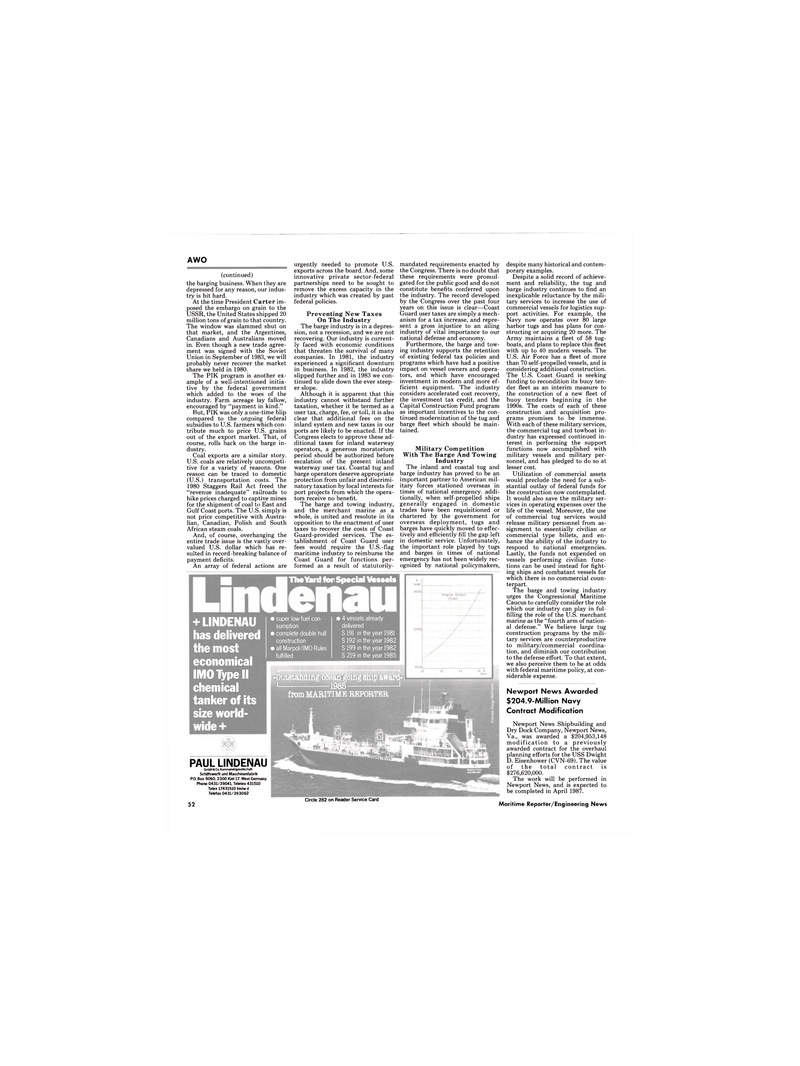
Page 50: of Maritime Reporter Magazine (January 1986)
Read this page in Pdf, Flash or Html5 edition of January 1986 Maritime Reporter Magazine
AWO (continued) the barging business. When they are depressed for any reason, our indus- try is hit hard.
At the time President Carter im- posed the embargo on grain to the
USSR, the United States shipped 20 million tons of grain to that country.
The window was slammed shut on that market, and the Argentines,
Canadians and Australians moved in. Even though a new trade agree- ment was signed with the Soviet
Union in September of 1983, we will probably never recover the market share we held in 1980.
The PIK program is another ex- ample of a well-intentioned initia- tive by the federal government which added to the woes of the industry. Farm acreage lay fallow, encouraged by "payment in kind."
But, PIK was only a one-time blip compared to the ongoing federal subsidies to U.S. farmers which con- tribute much to price U.S. grains out of the export market. That, of course, rolls back on the barge in- dustry.
Coal exports are a similar story.
U.S. coals are relatively uncompeti- tive for a variety of reasons. One reason can be traced to domestic (U.S.) transportation costs. The 1980 Staggers Rail Act freed the "revenue inadequate" railroads to hike prices charged to captive mines for the shipment of coal to East and
Gulf Coast ports. The U.S. simply is not price competitive with Austra- lian, Canadian, Polish and South
African steam coals.
And, of course, overhanging the entire trade issue is the vastly over- valued U.S. dollar which has re- sulted in record-breaking balance of payment deficits.
An array of federal actions are urgently needed to promote U.S. exports across the board. And, some innovative private sector-federal partnerships need to be sought to remove the excess capacity in the industry which was created by past federal policies.
Preventing New Taxes
On The Industry
The barge industry is in a depres- sion, not a recession, and we are not recovering. Our industry is current- ly faced with economic conditions that threaten the survival of many companies. In 1981, the industry experienced a significant downturn in business. In 1982, the industry slipped further and in 1983 we con- tinued to slide down the ever steep- er slope.
Although it is apparent that this industry cannot withstand further taxation, whether it be termed as a user tax, charge, fee, or toll, it is also clear that additional fees on the inland system and new taxes in our ports are likely to be enacted. If the
Congress elects to approve these ad- ditional taxes for inland waterway operators, a generous moratorium period should be authorized before escalation of the present inland waterway user tax. Coastal tug and barge operators deserve appropriate protection from unfair and discrimi- natory taxation by local interests for port projects from which the opera- tors receive no benefit.
The barge and towing industry, and the merchant marine as a whole, is united and resolute in its opposition to the enactment of user taxes to recover the costs of Coast
Guard-provided services. The es- tablishment of Coast Guard user fees would require the U.S.-flag maritime industry to reimburse the
Coast Guard for functions per- formed as a result of statutorily- mandated requirements enacted by the Congress. There is no doubt that these requirements were promul- gated for the public good and do not constitute benefits conferred upon the industry. The record developed by the Congress over the past four years on this issue is clear—Coast
Guard user taxes are simply a mech- anism for a tax increase, and repre- sent a gross injustice to an ailing industry of vital importance to our national defense and economy.
Furthermore, the barge and tow- ing industry supports the retention of existing federal tax policies and programs which have had a positive impact on vessel owners and opera- tors, and which have encouraged investment in modern and more ef- ficient equipment. The industry considers accelerated cost recovery, the investment tax credit, and the
Capital Construction Fund program as important incentives to the con- tinued modernization of the tug and barge fleet which should be main- tained.
Military Competition
With The Barge And Towing
Industry
The inland and coastal tug and barge industry has proved to be an important partner to American mil- itary forces stationed overseas in times of national emergency, addi- tionally, when self-propelled ships generally engaged in domestic trades have been requisitioned or chartered by the government for overseas deployment, tugs and barges have quickly moved to effec- tively and efficiently fill the gap left in domestic service. Unfortunately, the important role played by tugs and barges in times of national emergency has not been widely rec- ognized by national policymakers,
The Yard for Special Vessels + LINDENAU has delivered the most economical
IMO Type II chemical tanker of its size world- • super low fuel con- sumption • complete double hull construction • all Marpol/IMO Rules fulfilled • 4 vessels already delivered 5191 in the year 1981 5192 in the year 1982
S199 in the year 1982
S 219 in the year 1985 »0utstanding ocean going ship award« 1 1985 1 from MARITIME REPORTER
PAUL LINDENAU GmbH&Co Kommanditgesetlschaft
Schiffswerft und Maschinenfabrik
P.O. Box 9060, 2300 Kiel 17. West Germany
Phone 0431/39041, Teletex 431510
Telex 17431510 lindw d
Telefax 0431/393062 52
Circle 282 on Reader Service Card despite many historical and contem- porary examples.
Despite a solid record of achieve- ment and reliability, the tug and barge industry continues to find an inexplicable reluctance by the mili- tary services to increase the use of commercial vessels for logistics sup- port activities. For example, the
Navy now operates over 80 large harbor tugs and has plans for con- structing or acquiring 20 more. The
Army maintains a fleet of 58 tug- boats, and plans to replace this fleet with up to 40 modern vessels. The
U.S. Air Force has a fleet of more than 70 self-propelled vessels, and is considering additional construction.
The U.S. Coast Guard is seeking funding to recondition its buoy ten- der fleet as an interim measure to the construction of a new fleet of buoy tenders beginning in the 1990s. The costs of each of these construction and acquisition pro- grams promises to be immense.
With each of these military services, the commercial tug and towboat in- dustry has expressed continued in- terest in performing the support functions now accomplished with military vessels and military per- sonnel, and has pledged to do so at lesser cost.
Utilization of commercial assets would preclude the need for a sub- stantial outlay of federal funds for the construction now contemplated.
It would also save the military ser- vices in operating expenses over the life of the vessel. Moreover, the use of commercial tug services would release military personnel from as- signment to essentially civilian or commercial type billets, and en- hance the ability of the industry to respond to national emergencies.
Lastly, the funds not expended on vessels performing civilian func- tions can be used instead for fight- ing ships and combatant vessels for which there is no commercial coun- terpart.
The barge and towing industry urges the Congressional Maritime
Caucus to carefully consider the role which our industry can play in ful- filling the role of the U.S. merchant marine as the "fourth arm of nation- al defense." We believe large tug construction programs by the mili- tary services are counterproductive to military/commercial coordina- tion, and diminish our contribution to the defense effort. To that extent, we also perceive them to be at odds with federal maritime policy, at con- siderable expense.
Newport News Awarded $204.9-Million Navy
Contract Modification
Newport News Shipbuilding and
Dry Dock Company, Newport News,
Va., was awarded a $204,953,148 modification to a previously awarded contract for the overhaul planning efforts for the USS Dwight
D. Eisenhower (CVN-69). The value of the total contract is $276,620,000.
The work will be performed in
Newport News, and is expected to be completed in April 1987.
Maritime Reporter/Engineering News

 49
49

 51
51
